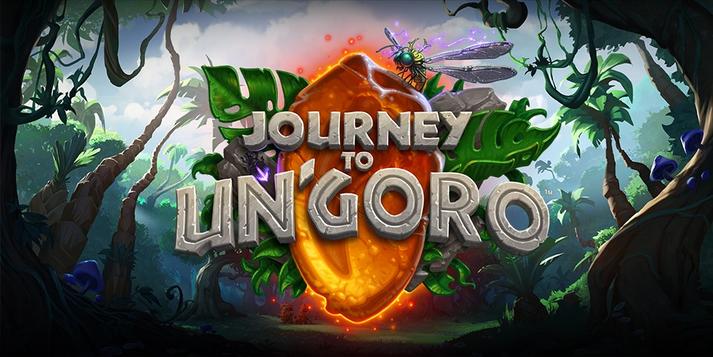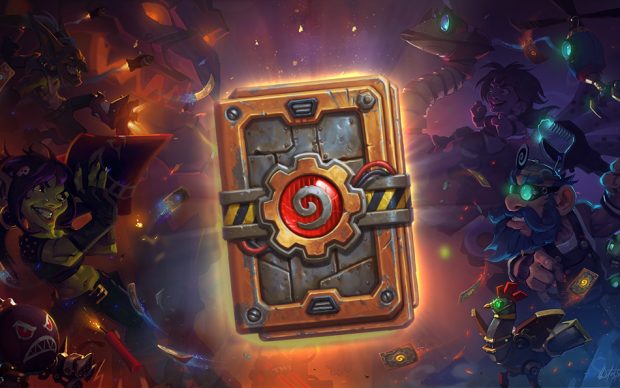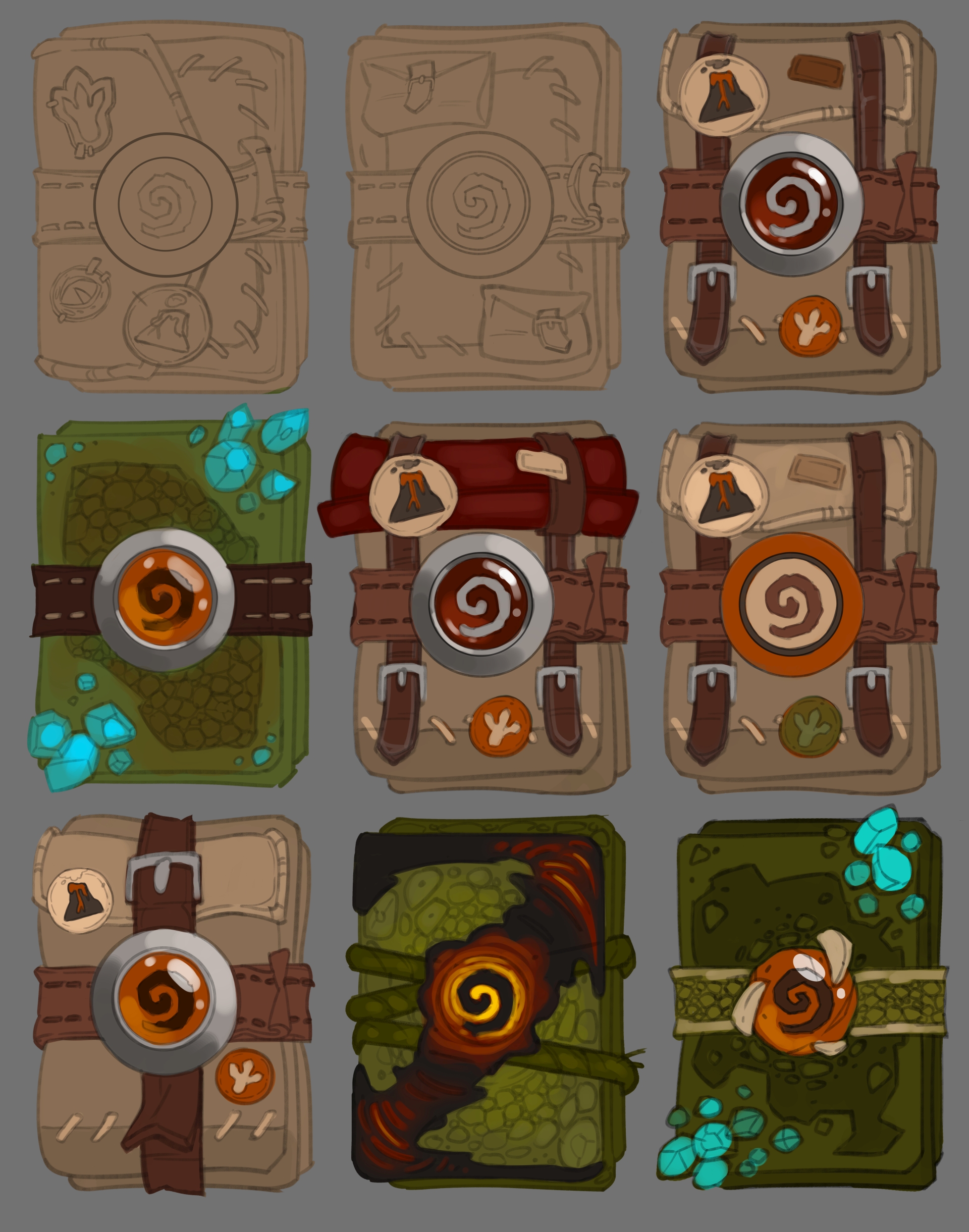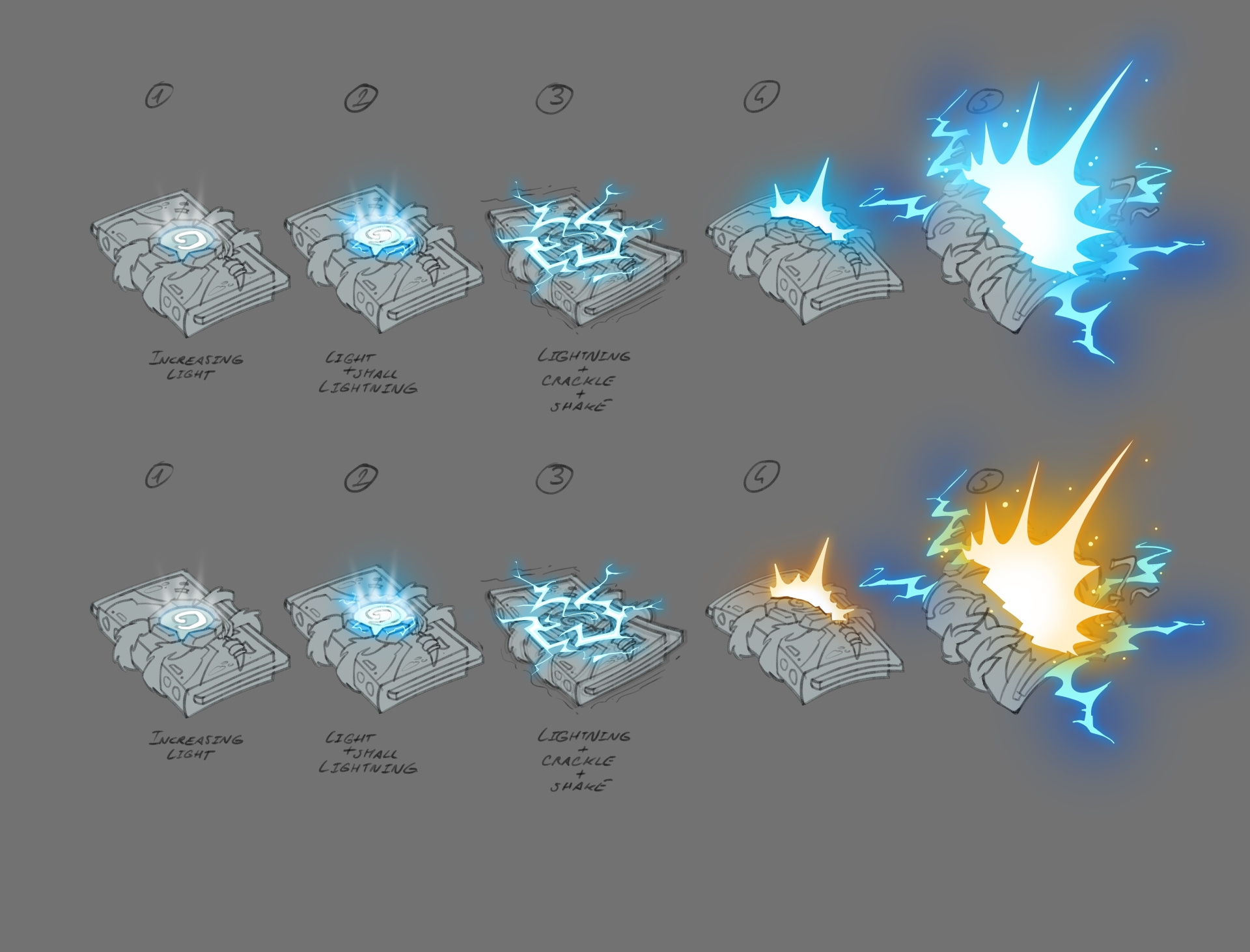 As you can probably already tell if you read TouchArcade, we really like Blizzard’s Hearthstone (Free), which shouldn’t surprise many given how popular and fun the game is. Between my weekly Touchstone roundups every Monday and all the other related stories we write, there’s often something Hearthstone-related to read on the site. Even though we write about quite a few aspects of the game, we’ve never talked about the process behind the design of the game’s card packs, which are often quite iconic. So, we got to talk to Ben Thompson, Art Director for Hearthstone, specifically about the process behind card pack design, and it was a great interview that covered card packs in general but also the design of the Journey to Un’Goro pack more specifically. We talked about how the team comes up with the card pack concepts, how those concepts are turned into the art we are so familiar with, and much, much more. Enjoy.
As you can probably already tell if you read TouchArcade, we really like Blizzard’s Hearthstone (Free), which shouldn’t surprise many given how popular and fun the game is. Between my weekly Touchstone roundups every Monday and all the other related stories we write, there’s often something Hearthstone-related to read on the site. Even though we write about quite a few aspects of the game, we’ve never talked about the process behind the design of the game’s card packs, which are often quite iconic. So, we got to talk to Ben Thompson, Art Director for Hearthstone, specifically about the process behind card pack design, and it was a great interview that covered card packs in general but also the design of the Journey to Un’Goro pack more specifically. We talked about how the team comes up with the card pack concepts, how those concepts are turned into the art we are so familiar with, and much, much more. Enjoy.
Let’s start with some questions about the process of card pack design more generally and then talk about the Journey to Un’Goro card pack more specifically. How many people usually work on the card pack design process from beginning to end?
If all goes according to plan and smoothly, we have a concept artist responsible for the 2D art who comes up with what the card pack looks like and then paints the 2D aspect of the asset, we have a 3D modeler who will then model that 2D asset into 3D space and hook it up in the game, and sometimes, though sometimes not, that modeler will then take it to Effects. If not, we have an effects person that will be responsible for the packs opening event. So, each gets a unique opening animation, and they work very closely with myself and the concept artist, who will by that point have done a storyboard of the opening animation, so that it feels exactly like [we want it to] and hits all the beats we want it to hit [in terms] of the expansion and of the game. And then at that point, we start testing them into the game and put some cards in them.
I’m guessing the team is bigger now than it was when the game originally launched.
It absolutely is, yes. We take it as a good sign. Generally needing more people is usually a sign of a good problem to have. We’ve been really fortunate to have a fanbase and a body of players that requires that kind of output, and the size of the game necessitated the size of the team we are now.
I’ve talked to other Hearthstone developers in the past about the design process overall, so I know the way expansion ideas are generated (everyone brainstorms together until one idea gains traction). At which part of the brainstorming process does the pack design team come in? Are you there from the beginning, or do you wait until there’s something more concrete to work with? And at what point do you start thinking of the card pack design?
I’m involved usually from the very beginning. I’m involved with the game director or the lead designer for a particular set as they start to bat around ideas for what they think would make a compelling expansion. I’m working with them very early on to help them find those cool, interesting, very fun, very Hearthstone whimsical ideas. Pretty soon after that, we will start to branch out and incorporate one if not two or three of the 2D artists from the art team to start completing a sort of visual style guide to the set that’s still admittedly somewhat nebulous. We have this general setting and feel, and we want these things to support this new mechanic, this new card type, whatever the case may be.
Ultimately, wherever Art can help from a visual style guide point, we will. That doubles over in that it doesn’t just help the internal team, the Hearthstone team as a whole; we will then be able to use those assets in a more formalized way, to create a kind of style guide for external artists. If you look at all the cards in a set, those all go to individual artists who are responsible for the art that goes on a card, and really one of the only ways or tools we have to ensure the art feels very similar or of the same set is that style guide. So, they will have those to reference when looking at certain creatures or types or the feel of the environment, or whatever the case may be. So, very early in the process you already have 2, 3 artists involved.
By the time something like the pack comes around, Design [has] really blocked out the set, and we definitely have a vibe down now and a feel if not an outright theme for the set itself, and it’s under that kind of atmosphere that we start to talk about what in the form of a pack really encapsulates the idea of that set succinctly. It’s not dissimilar to the process we have for card backs. Many of the sets have one or more card backs attributed to them as well; the difference here is you don’t want your card back to look like your card pack. They should very definitely be different things; one is for an individual card, and the other one contains 5 cards. So, it should feel substantially more, it should be bigger and, at a glance, definitely different than a card back.
And the card packs also have a much more three dimensional feel to them that’s different than the card backs.
Yes, you won’t see card backs interacted with in the same way. They are both 3D and both modeled out and have effects and everything on them, but because of the nature of the cards opening, when you put [the card pack] in the summoning space and it throws it up in the air and kicks it to a three quarters view, you’re really going to see that three-dimensionality more than your cards in the Collection Manager, where they wiggle a bit to the right and left but stay pretty much face on.
Which card pack was the most difficult one to design?
I don’t have to think very long about that because it took three artists to actually figure this out. It was The Grand Tournament. The first version of that was almost like chain mail, and it had a lot of metal pieces on it. The one thing that didn’t change was the shield in the middle. Everything else changed at some point. We went through countless versions of that. The 2D artist at the time who was responsible for the card pack threw up his hands and was like guys, I’ve done like fifteen of these things. Then another one picked up, said I’ve got this, no problem, drew four, five more, until he threw his hands up. At that point I came in and worked with them, [we] dedicated a number of hours and painted on top of each others’ stuff, and finally what you got was genuinely a piece of art that was three artists doing their best to try and figure out what the card pack would look like at the end. So, probably the only pack that wasn’t one artist but three of them trying to find a way. Definitely the most difficult.
On the other end of the spectrum, which one was designed with comparatively no effort?
Goblins Vs Gnomes is way up there. It felt very Goblins vs Gnomes, very mechy. Recently, Mean Streets of Gadgetzan was a pretty direct one. There were one or two sketches, but then when we hit the safe, we said that’s it, that’s awesome. When it opened, it was like cracking a safe or giving up and blowing the thing up. That one felt very cool and had a unique, interesting opening feeling.
Moving on to the Journey to Un’Goro card pack, what were your inspirations behind the art?
This one could probably fall under one of the easier ones in terms of generally knowing what we wanted outright. There wasn’t a lot of back and forth to [figure out] exactly how it should be. We knew it would be of dinosaur material. One of the most exciting parts of Journey to Un’goro is all the dinosaurs and all the primordial features of that land, so for sure we were making it out of leather again, but this time it’s the leather hide of a dinosaur. That feels very much of this region, and getting the claws and the things attached to [the hide] in an almost fetish or totem kind of way felt really cool. There’s also the idea of the elemental totem or shaman stuff.
We did a couple of rounds on it to figure how the hide itself would look like. Was it a pattern, was it bright colors, did it look too much like a dragon if we did this to it or we changed the scales in that way? As a result, the texture that’s there now is like an alligator skin. If we look at visual themes on animals today that we can link all the way back to prehistoric times, alligators and crocodiles are right up there, and they feel primordial when you see them.
 So, we really started to guide the 2D artists more along the route of let’s try some of that and see what we get, and Charlene [Le Scanff] was the one that ended up doing this pack, and she really did a good job getting those things put together; if anything, we had to [make sure there wasn’t] too much pattern, too much color. We needed to make this feel like a consistent, cohesive physical piece. There were some really cool ideas, so we worked on it until it looked like a believable set of hides that feels like it’s been torn and ripped and cut but was fashioned into something that feels respected, like a classic, almost revered piece of art.
So, we really started to guide the 2D artists more along the route of let’s try some of that and see what we get, and Charlene [Le Scanff] was the one that ended up doing this pack, and she really did a good job getting those things put together; if anything, we had to [make sure there wasn’t] too much pattern, too much color. We needed to make this feel like a consistent, cohesive physical piece. There were some really cool ideas, so we worked on it until it looked like a believable set of hides that feels like it’s been torn and ripped and cut but was fashioned into something that feels respected, like a classic, almost revered piece of art.
I’m looking at some of the other earlier card pack concepts, like the ones that look like backpacks. Why did you move away from that idea?
We liked that initially, and I think the reason we were going for that was, as you saw in the cinematic, Elise Starseeker is with her junior league of explorers, and for a time we thought about leaning into all that junior league of explorers stuff, all the fun things that come from scouting the great outdoors, camping, and exploring the crater. But ultimately, when we sat back and started talking to the design team and other members as well—Production, Art—what everyone was most excited about wasn’t scouting, it wasn’t the junior explorers or even Elise, as powerful as those tropes can be.
What we were excited about was dinosaurs, and what we really wanted to spend time with was giant lizards, huge gigantic lizards and their kin roaming this realm of Un’Goro unscathed. That ended up guiding us back to how we didn’t want to send mixed messages and be confusing with the pack [since] dinosaurs is what we see as the most compelling part of this entire expansion.
The relatively serious tone of the expansion is an interesting change from the more playful tone of previous expansions. Is that shift in tone part of how this expansion was conceptualized, or did you intentionally set out to make it less playful than most of the other expansions?
If you look back across the entire timeline of Hearthstone sets, we do go back and forth we play fast and loose with when we are serious and when we are more lighthearted. We got a bit serious with one set, maybe the next one we want to be more lighthearted. When you start comparing and contrasting between let’s say Whispers of the Old Gods and something like Karazhan, the two couldn’t be more different in terms of their vibe. In Mean Streets you get a bit more serious, but it’s also lighthearted as well. And then going to something like Journey to Un’Goro, yes it is lighthearted [with] Elise and the junior explorers. It’s also serious in the sense that this crater means business, everything down there is in primordial form, but it doesn’t mean it’s in its nicest form, it’s very startling and breathtaking as well. So, we do go back and forth. It depends what the set really wants to be and where it finds its voice more successfully in terms of the vibe for that. We’ll be looking at past sets when we design future sets.
Going back to the card pack you actually picked, you’ve talked a bit about the various elements of the pack already, but could you talk a bit more about the details on the pack like the stitches on the top right and the teeth? Was there anything else that didn’t end up making it in the final design?
While the bulk of it is definitely dinosaur, if you look at the hide and the scales, there’s also a fur element and then another not dinosaur-based leather element. I think some of that was an attempt to show that it’s not all scaly lizard things and dinosaurs. There are also woollier fur creatures, there’s the tortollans, which are shell based and have much harder carapace shells to them. The teeth and the fangs hanging from it, it makes you wonder whether they are fangs or teeth. What do these go to, are they from the dinosaurs the pack was made out of, or is that yet another creature? I think it was more an attempt to amass a number of elements that pointed to the many places that Un’Goro goes with regards to its natural denizens and then what the powers of evolution do to them after the fact as well. All of those things were really important to convey to the player and was really what made it exciting for us.
The center jewel piece, there’s always a center jewel piece to packs that shatters when they open. This one was obviously distinctly meant to be amber, and it’s a call back to all of our favorite Jurassic moments with things trapped in amber. I remember as a kid being fascinated with amber with insects in it and thinking [about] how awesome that it, what a piece of history. So, putting the swirl trapped in amber felt as an awesome replacement of what was generally a gem.
Moving on to the animations, I see there were different versions; one looks like it has a claw in it, one has lava pouring out. You went with the lightning one. Why did you pick that one?
The claw one was a contender for a while, and we were definitely excited about the visceral, physical quality of it. But what we didn’t like was it almost lent itself too much to the dinosaur quality that we spent so much time putting in the pack, and we didn’t want it to feel like there are things trapped in there, like the cards are clawing their way out or something clawing its way in. It just started asking a number of questions we didn’t think were important enough to really draw attention to, so instead what we did was step back and say okay, the whole set is not about dinosaurs, as much as we are excited about them and as much as we feel those are things we want to really celebrate; it’s also about elemental magic, elemental power and what that elemental power does to the dinosaurs and the denizens of Un’Goro.
That’s where the lightning came in kind of an aha moment; maybe we just keep with magic but we make it elemental. That way, we get the dinosaur pack being affected by the lightning, and maybe the evolution of the pack is to open and show your five cards. So, it’s evolving the pack in a way, opening it and giving you five cards from the set.
Have you ever considered having more than one pack opening animation? One time you get this one, another time you get that one, and so on.
I think we certainly could. Some of the [concerns] that I would immediately have, I would want to make sure we weren’t telling the players something that wasn’t true, because I think that is human nature, to psychologically look for reasons for things when there’s actually randomness involved, and in pack opening there’s randomness involved, there are five random cards that are coming my way. I’m going to start looking for patterns and meaning behind anything I can. If [I see] two or more different animations, I will start to wonder that maybe one of them indicates that there will be different cards in this one than the last one, or the last time I saw that animation I got a legendary cards, that means the next time I open it there will be another. I wouldn’t want to make someone look for meaning behind things that wouldn’t really have any meaning. As fun as it would be to make, I would rather have players focused instead on what the cards they are going to get are and that the single animation they are getting feels evocative of the set it is attached to.
If you weren’t worried about misleading players, if you could have picked another animation, which one would you have picked?
I do like the claw one for the physicality of it. I do think there’s something there. I would want to adjust it from what it is now because it felt too aggressive, like the pack was being damaged and attacked. The reaction of more than a couple of members of the team when they saw it was whether it hurt their cards. That was a sure sign that we might have gone too physical, there’s too much aggression during this [pack] opening. So if we had pursued that path further, I would want to find a way that made it felt like the cards were pushing and prodding to get out of the pack, which would have been an interesting take on that.
Have you ever had a discussion about turning the card packs into collectibles? I would definitely buy most of them.
I think that would be fun for sure. I know members of the development team and I have talked in great lenghts about this. We know we generally have found a really cool design when somebody else on the team or even people elsewhere in the company says oh my God, I want that, is there a way to make a wallet out of that? Okay, that’s a design that’s compelling and people like it, they want to see it and hold it and touch it. It would be interesting. I think we would want to find a way that makes the most sense. I know they’ve made wallets for the gear store, and I know there have been luggage tags, but you’re right, sometimes it’s art for art’s sake, and it would be cool to make one just to make one.
I’m asking because since they are so physical and three dimensional, they would make great collectibles to put on a desk.
Funny enough, originally you undid the [pack] ribbon, it unfolded once, and then the top and the bottom flaps opened and it unrolled like a leather tool wrap. As nice as that was, we were like okay, we’re going to spend time opening the ribbon, and then the flaps opening; let’s just blow the thing up. Initially they were meant to open like a fine leather tool case.
Thank you for the interview and good luck with the Journey to Un’Goro release!






